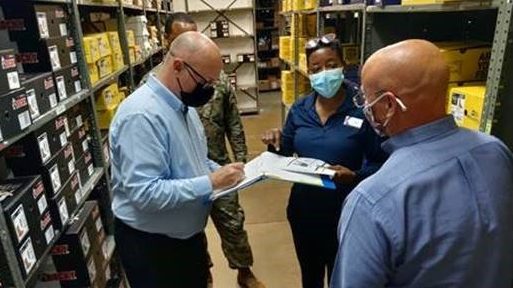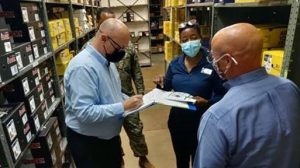During Lunch-and-Learn, COO Jason Rosenberg Stresses Importance of Diversity in Mentoring

Jason Rosenberg, the Exchange’s chief operating officer, encouraged associates attending a July 29 virtual lunch-and-learn to not only seek out mentors, but to seek mentors who have different backgrounds than theirs.

COO Jason Rosenberg
“I want you guys to focus more on deliberately reaching out and making an effort to gain a mentor or mentee that is from a different ethnic group or gender,” Rosenberg, who is also chairman of the Exchange Diversity Board, told the 400 virtual attendees. “And I want mentors to seek out diamonds in the rough. If you find folks you really see potential in, I want you to make an effort to take them under your wing and formally mentor them.”
Diversity in mentorship introduces mentors and mentees to insights they might not have discovered by themselves, he said.
“It creates a rich learning environment, both for the mentor and mentee, to engage with folks who are different and have different backgrounds and life experiences,” said Rosenberg, who mentors several Exchange associates. “I know I’ve benefited greatly from that.”
Rosenberg cited studies finding that companies with an emphasis on diversity and inclusion are 120% more likely to hit their financial goals than less inclusive ones, and that teams with a diverse makeup are 87% more likely to make better decisions than individuals.
“Diversity is really the starting point for creating a more vibrant and productive workplace,” Rosenberg said. “When you invite people from different backgrounds and perspectives to collaborate, then you can start seeing and fostering an environment where new ideas are generated.”
Rosenberg, who started at the Exchange as custodial worker in 1989 and was main store manager at Whiteman AFB by 1999, said that although he moved up quickly, he didn’t really have a mentor for his first 10 years, until Marty Maston, vice president of Central Region at the time, connected him with Karen Stack, vice president of Western Region then and now EVP of Logistics.
Rosenberg shared a story about how Stack handled mentorship when he was nervous about giving a presentation. She asked him to do the presentation for her first, and then she asked him a couple of unexpected questions.

During a visit to the Fort Sam Houston Exchange this year, COO stops by the Military Clothing Store and confers with manager Tonya Yancey. Also pictured are Air Force Chief Master Sgt. Kevin Osby, the Exchange’s senior enlisted advisor (partly obscured) and JBSA-Fort Sam Houston Exchange General Manager Eddie Devlin (back to camera).
“When we got into the board room and I was up there presenting, I got through the presentation and said, ‘Are there any questions?’” Rosenberg said. “And Karen Stack raised her hand and asked me the same questions she asked me that morning, throwing me some softballs and making me look smart and at ease. That was my first exposure to how a mentor could support a mentee.”
Around 2007, he turned to Karin Duncan, now senior vice president of the Pacific Region, for mentorship. He would talk to her about operational problems he was having, and she would give him technical or operational advice. Sometimes they talked about challenges with associates or even how to better manage his boss. She always gave him great advice and both of them kept the conversations confidential, building a trust relationship.
“And then I went to work for her in 2012,” he said. “One of the first things she said to me was, ‘You know, you’re not going to be my mentee anymore because I am now your second line supervisor,’ That’s an important point. Your boss is not necessarily a good fit to be your formal mentor. You should seek a mentor that’s outside of your normal chain of command. At least two or three steps removed.”
Rosenberg said that as a mentor himself, he had his own learning curve. He presented a list of Mentoring Engagement Best Practices, including “protect mentoring time,” and acknowledged that he had to overcome his own issues with that.
“This is where I fell off as a mentor, until maybe the last seven or eight years,” Rosenberg said. “Because I didn’t take the time to deliberately make sure that touch points were formally set up. … I went through a phase where I told mentees, ‘I’ll be your mentor. I’ll leave it up to you to set up meetings.’ In a lot of cases the meetings never happened.”
Now Rosenberg makes sure that he has one-on-ones with his mentees at least twice a year, as well as quarterly group meetings. But he also tells them to connect with him any time they need to.
“When you’re in a mentoring session, be 100% all-in,” he said. “Give your mentee your undivided attention. Don’t multitask. Don’t turn off your camera. Truly listen, absorb and provide feedback. It’s a two-way conversation.”
Other best practices include:
- Set the goals and conditions of the mentoring relationship. Ask mentees what they expect to gain from a mentorship and what they see as their areas of development.
- Create a mutually beneficial relationship. “Mentoring should not be a stressful relationship and it should be fun as well as a win/win for both parties,” Rosenberg said. “It’s an opportunity to learn from each other and sharpen many skills. If your mentoring includes diversity, you will see growth in areas you have never seen before.”
- Focus on building trust. “This takes time and patience and it takes a willingness to be open,” Rosenberg said. “It also takes discipline so that trust is not abused. Make sure that you protect confidentiality and allow your mentees to be open.”
- Give honest and direct feedback. “It stings a little bit sometimes to do that,” Rosenberg said. “But you owe it to your mentee to be honest even if sometimes there’s a negative perception about them or they have skill gaps. It’s the only way you’re going to help them.”
“I firmly believe that mentoring can and will be a driver for diversity and inclusion,” Rosenberg concluded. “I’m asking each of you, can you do more to help the Exchange become even richer with diversity and inclusion at all levels through your mentoring efforts?”
Rosenberg’s presentation was recorded. If you missed it, you can view it here.

